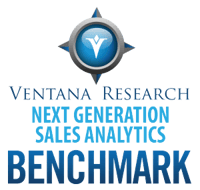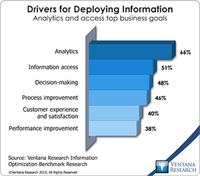All lines of business are under pressure to meet targets and deliver expected results, but none is under more pressure than Sales. Like other organizations it must use information to derive insights about progress and problems and to decide what changes to make. Today businesses collect and analyze data from more data sources in more forms than ever before. To understand it they need effective analytics, and again none need it more than Sales.
Read More
Topics:
Big Data,
Sales,
Operational Performance Management (OPM),
Business Analytics,
Business Collaboration,
Business Intelligence,
Cloud Computing,
Business Performance Management (BPM),
Financial Performance Management (FPM),
Information Applications (IA),
Sales Performance Management,
Sales Performance Management (SPM),
SFA
Maximizing the performance and value of people in the workforce should be a primary focus for any business these days. It is a complex task, especially for larger organizations, and chances for success can be increased by investment in human capital management (HCM) applications. In this competitive software market SAP is making a strong push, aided by acquisitions in the last three years of SuccessFactors for talent management and more recently Fieldglass for contingent labor management....
Read More
Topics:
SAP,
Social Media,
HCM,
Human Capital Management,
Learning,
Operational Performance Management (OPM),
Performance,
Recruiting,
SuccessFactors,
Analytics,
Business Analytics,
Cloud Computing,
Business Performance Management (BPM),
Compensation,
Financial Performance Management (FPM),
HRMS,
Vendor Management Systems,
Workforce Analytics,
Workforce Management,
Workforce Planning
Data is an essential ingredient for every aspect of business, and those that use it well are likely to gain advantages over competitors that do not. Our benchmark research on information optimization reveals a variety of drivers for deploying information, most commonly analytics, information access, decision-making, process improvements and customer experience and satisfaction. To accomplish any of these purposes requires that data be prepared through a sequence of steps: accessing, searching,...
Read More
Topics:
Big Data,
Predictive Analytics,
Operational Performance Management (OPM),
Analytics,
Business Analytics,
Business Collaboration,
Business Intelligence,
Business Mobility,
Cloud Computing,
Data Preparation,
Location Intelligence,
Operational Intelligence,
Business Performance Management (BPM),
Customer Performance Management (CPM),
Financial Performance Management (FPM),
Information Applications (IA),
Information Management (IM),
Information Optimization,
IT Performance Management (ITPM),
Sales Performance Management (SPM),
Supply Chain Performance Management (SCPM),
Workforce Performance Management (WPM)
At its annual MicroStrategy World conference, this provider of analytics and business intelligence systems for business and IT introduced a new version of its flagship product, MicroStrategy 9s. Among many advances it adds enterprise grade security with MicroStrategy Usher as part of the maintenance update to its 9.4.1 release. Security is increasingly critical for analytics and BI. Technologies that work intensively with data, including reporting, business intelligence, analytics and data...
Read More
Topics:
Big Data,
Mobile,
Governance,
Operational Performance Management (OPM),
Analytics,
Business Analytics,
Business Collaboration,
Business Intelligence,
Cloud Computing,
Business Performance Management (BPM),
Customer Performance Management (CPM),
Information Applications (IA),
Information Management (IM),
Risk & Compliance (GRC),
Sales Performance Management (SPM),
Security
Most people in business management admit that sales is more an art than a science. Organizations have long struggled to find the right mix to improve its effectiveness, and few get the most out of available technology. For many the default is still to use sales force automation (SFA) and spreadsheets to manage processes and try to increase the productivity of sales staff. In our view they should take a holistic approach to sales processes from contact to close and support everything from sales...
Read More
Topics:
Sales,
Operational Performance Management (OPM),
Recurring Revenue,
Sales Compensation,
Sales Forecasting,
Business Collaboration,
Business Mobility,
Cloud Computing,
CRM,
Customer Performance Management (CPM),
SFA
Big data has become a big deal as the technology industry has invested tens of billions of dollars to create the next generation of databases and data processing. After the accompanying flood of new categories and marketing terminology from vendors, most in the IT community are now beginning to understand the potential of big data. Ventana Research thoroughly covered the evolving state of the big data and information optimization sector in 2014 and will continue this research in 2015 and...
Read More
Topics:
Big Data,
MapR,
Predictive Analytics,
SAP,
Human Capital,
Mulesoft,
Operational Performance Management (OPM),
Paxata,
SnapLogic,
Splunk,
Business Analytics,
Business Intelligence,
Cloud Computing,
Cloudera,
Hortonworks,
IBM,
Informatica,
Information Management,
Operational Intelligence,
Oracle,
Business Performance Management (BPM),
Customer Performance Management (CPM),
Datawatch,
Dell Boomi,
Financial Performance Management (FPM),
Information Management (IM),
Information Optimization,
Sales Performance Management (SPM),
Savi,
Sumo Logic,
Supply Chain Performance Management (SCPM),
Tamr,
Trifacta,
Strata+Hadoop
Managing investments in people and their performance is critical to every organization. It also is complicated. To support the various aspects of human capital management (HCM), organizations often use a variety of technology including systems for human resource management, talent management, workforce management and payroll management. Often these separate systems use their own information and are not well connected to each other. Today they are deployed both on-premises and in cloud computing...
Read More
Topics:
HCM,
Human Capital,
Human Capital Management,
Operational Performance Management (OPM),
Business Performance Management (BPM),
Customer Performance Management (CPM),
Financial Performance Management (FPM),
HRMS,
Supply Chain Performance Management (SCPM),
Talent Management,
Workforce Management
As organizations look to improve the competency and skills of their workers, learning management system (LMS) technology can help improve their efforts. Our latest benchmark research innext-generation learning management systems finds a range of progress in this regard. Our Performance Index analysis places organizations almost evenly between the two lowest (51%) and the two highest (49%) of four levels of performance. The results differ by size of company as measured by number of employees....
Read More
Topics:
HCM,
Human Capital,
Human Capital Management,
LMS,
Operational Performance Management (OPM),
Business Performance Management (BPM),
HR,
Talent Management
This year presents much opportunity for organizations to use a new generation of technology to compete better, be more efficient in their business operations and engage their workforces to their full potential. We have identified and begun to track the following next-generation technologies: analytics, big data, collaboration, cloud computing, mobile technology and social media, and in 2014 we added wearable computing to the list. In 2015 we will intensify our focus on all of them specifically ...
Read More
Topics:
Big Data,
Social Media,
Governance,
Mobile Technology,
Operational Performance Management (OPM),
Wearable Computing,
Analytics,
Business Analytics,
Business Collaboration,
Business Intelligence,
Cloud Computing,
Collaboration,
Location Intelligence,
Operational Intelligence,
Business Performance Management (BPM),
Customer Performance Management (CPM),
Financial Performance Management (FPM),
Information Applications (IA),
Information Management (IM),
Risk & Compliance (GRC),
Sales Performance Management (SPM),
Supply Chain Performance Management (SCPM),
Technology Innovation,
Workforce Performance Management (WPM)


















